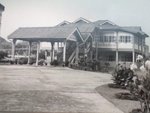[Note: The following was reported on Asia Sentinel written by John Berthelsen, 19th June 2008.]
The oil-rich sultanate is trying to sell 3 modern warships its navy can’t use .
Want to buy a high-speed warship, cheap, never used, bristling with some of the most advanced weaponry on the high seas? Three of them, in fact? Call Brunei. They can’t use them.
Ever since the sultanate settled a confidential contract dispute over the vessels in the International Court of Arbitration in June 2006, its navy has been trying to get rid of three 95-meter-long corvettes, built by BAE Systems of the UK. Since July 2007, they have been parked in Walney Channel near BAE’s shipyard at Barrow-in-Furness in northwest England while Brunei seeks a buyer. The price for the three is ₤600 million (US$1.71 billion).
They are now in the hands of the German luxury yacht builder Fr. Lürssen Werft GmbH & Co. KG, which has been looking for a buyer for more than a year, rather than a military broker. A Lürssen Werft spokesman, asked about the three ships, said he would inquire and get back to Asia Sentinel, but so far hasn’t done it. One source said the three ships are being offered to the United Arab Republic, possibly through sources in Singapore. Malaysia also is believed to have looked at them briefly.
“They have been taken away by the customer,” said a spokeswoman for BAE. “As I understand it, they are somewhere in the northwest, but they are not with BAE Systems. As far as the business is concerned, the customer took delivery. They are no longer moored with us.” She would not comment further.
The story began in 1995 when Brunei, which has only 66 miles of coastline, went looking for advanced protection for its 313,000 citizens, its oil reserves and its fabulously wealthy royal family. Brunei declines comment on its military affairs. But one source with connections to the Brunei government said that Sultan Hassanal Bolkiah is believed to have been swayed by a desire to project Bruneian naval power in an effort to hold the country’s portion of the much-disputed Spratly islands.
The Spratlys are a string of 51 small islands and reefs, 44 of which are claimed or occupied by every country contiguous to the South China Sea including China, the Philippines, Vietnam, Taiwan, Malaysia and Brunei, in a bid for fishing and energy rights. Brunei only recently became an active player in the Spratly dispute by claiming the Louisa Reef adjacent to its coastline in an apparent attempt to forestall any claims on its coast or its nine oil fields in the South China Sea, which average about 143,000 barrels per day.
Already protecting Brunei’s coast, according to some reports, are the Royal Brunei Navy’s three guided-missile patrol craft armed with MBDA Exocet antiship missiles, three smaller patrol boats, two amphibious craft, two landing craft, 17 small armed river boats used by the Special Combat Squadron, a support launch and 23 Marine police patrol boats.
The armaments aboard the three corvettes appear to be sophisticated enough to chase some of the other countries off whichever Spratly Brunei might decide it wants, let alone hold off any attackers likely to show up in Bruneian waters, situated as they are on the north coast of Borneo on the South China Sea. Aboard each of the three are these systems:
- NAUTIS II command and weapon control system;
- MBDA VL Seawolf point defence missile system
- Oto Melara 76/62 Super Rapid gun
- MBDA MM40 Block 2 Exocet anti-ship missiles
- two MSI-Defence single 30 mm REMSIG gun mountings
- two sets of triple torpedo tubes
- BAE Systems Insyte AWS-9 surveillance and target indication radar
- Ultra Electronics System 2500 electro-optical tracking system
- Thales Cutlass 242 electronic support measures outfit and Scorpion jammer
- Thales TMS 4130C1 hull-mounted medium-frequency sonar.
The Royal Brunei Navy’s current strength is about 750 personnel. Each of the three corvettes would require a crew of about 100 personnel and normal naval practice is to train at least two full crews per warship. The new ships would have required at least another 600 men for even the most basic operations, not to mention shore-based support personnel, according to a military analyst based in the UK, effectively requiring almost the doubling of the country’s navy.
“Operating and maintaining this kit would absorb much of Brunei’s small cadre of technically proficient workers, few of whom would be remotely interested in bobbing around the South China Sea being shouted at by people considerably less competent than themselves,” the analyst said.
Brunei refused to accept the ships in 2004, saying they were not up to specification, and attempted to return them to BAE systems. They were forced to take them in the wake of the court case.
But, said the military analyst: “Recognition (that the ships were too complex) came slowly to the sultan and his people, and when it did they first sought a face-saving deal – perhaps calculating that they could arbitrage the three patrol vessels against a possible order for jet aircraft also built by BAE. This clearly did not work and the issue went to law – with the outcome described above.”
Brunei, with its vast oil wealth, has always gone first cabin for military equipment, partly because of the sultan’s personal proclivities. A trip to the Singapore Air Show or other military hardware fairs by the sultan can turn into a show itself as various gun-runners, quick-change artists, armaments dealers and military attaches from countries trying to sell the sultanate hardware cluster around him like bees to extremely lucrative honey.
The sultan himself, educated at the British Royal Military Academy at Sandhurst, pilots his own helicopter. His air force consists mainly of helicopters -- six Sikorsky Blackhawks, five Bell JetRangers, 10 Bell Twin Hueys, six German MBB Bo 105 utility helicopters and a flock of other gear. Plans for fighter capability through the purchase of BAE Hawks apparently are off, presumably after the attempt to trade them for the corvettes fell apart.
The three ships may be hard to sell. According to a July 5, 2007 story in the Times of London, they were designed with doors and beds constructed for smaller, Asia-size sailors. Because they were designed for duty in the warm waters of the South China Sea, they also lack heating. Strategic considerations could also limit their sale. Given their state-of the art missile guidance and target-tracking systems, Exocet mountings and other hardware, the western alliance would frown if buyers from, say, North Korea, Burma or Iran were to express an interest.
Welcome to my private journal generally on Brunei issues. Any opinions expressed are in my personal capacity. All rights to the articles are reserved.
Friday, June 20, 2008
Subscribe to:
Post Comments (Atom)







No comments:
Post a Comment